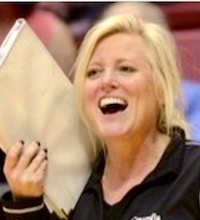How many countless times have you yelled, “TALK!!!!” at your players after an error? Maybe your players aren’t communicating because they don’t know WHAT to say! Have you spent time teaching your players HOW to communicate? Communication is a skill just as much as serving and passing. It’s something that must be taught and practiced every day. Communication needs to be broken down part to whole just like you would do with any other skill of the game. To create great communicators in your program you must make communication a standard in your program.
A standard; something you do every day and are held accountable for.
Laying out an explicit guideline for what needs to be communicated before the ball is in play, during the rally, and after the point is the crucial first step to teaching your players to communicate with a high volleyball IQ. Communication is different than chatter. We don’t need players yelling, “Setters down” five times and then jumping with the back row setter. Communication is saying what you see and processing that information.
At Summit our communication standards are broken down into Pre-Contact, During Contact and After Contact. We take time in every practice to teach these communication standards to our players. It is up to coaches to hold every player accountable to these standards.
Pre-Contact Communication (Defense)
- IDENTIFY TEAM DEFENSE
- IDENTIFY SETTER POSITION
- A. Verbal Cue: “Setter UP”, “Setter Down”
- IDENTIFY HITTERS
- Verbal Cue: “3 Hitters, #5 is front row.”
- IDENTIFY WHERE YOUR HITTERS ARE COMING FROM
- Verbal Cue: “Split” “Stacked”
- IDENTIFY PLAYS
- Verbal Cue: “Watch the #8 on the slide, Watch #5 come up the middle”
- IDENTIFY ADDITIONAL INFORMATION
- Hitters tendencies, Left handed hitter
Pre-Contact Communication (Serve Receive)
- IDENTIFY SET OPTIONS
- Verbal Cue: Setter tell hitters what they want run “hut, A, C” B.
- Non-Verbal Cue: Hand signal from setter to hitter AND eye contact
- IDENTIFY SERVE RECEIVE PASSING ASSIGNMENTS
- Verbal Cue: Passers Identify lanes, passing assignments “I have seam”, “I have your short” “I have your deep”
- Non-verbal Cue: Point to lanes that are your responsibility
- IDENTIFY OPPONENTS SERVING TENDENCIES
- Verbal Cue: Passers identify servers tendencies, “Jump server”
- EXAMPLE COMMUNICATION CUES: “Top spin server” “Short server” “float server” “zone 1 server” “deep server” “served you last time”
During Rally Communication
- CALL THE BALL
- Verbal Cue: “MINE” One word, aggressive, everybody in gym knows it’s yours
- Non-Verbal Cue: Go ALL Out, absolutely no hesitation
- TRANSITION
- All hitters call for the ball and go! “A, A, A”
- Backrow yells cover & calls shots. “Cover, line!”
- All players get back to base & say “Base”
- IDENTIFY WHAT’S HAPPENING ON THEIR SIDE OF THE NET
- Identify the pass: “ON” “OFF”
- Identify where the set is going: “Outside, outside, outside”
- Identify & read where the ball is being hit: “Tip” “Line” “Seam”
Between Points Communication
- EVERYONE GATHERS IN CENTER OF COURT
- Verbal Cues : ex. “Good swing”, “keep it going”, “we got it”, “next ball”
- AFTER EVERY POINT, EVERY PLAYER SAYS SOMETHING POSITIVE (Bench too!)
- Verbal Cues: ex. “YES!” ,”Awesome serve”,”Hammer”, “Great Dig”, “Way to pass” “Perfect set”, “you got it”, “you’re a digging maniac”
- BE AS HAPPY FOR YOUR TEAMMATES SUCCESS AS YOUR OWN, HER SUCCESS IS YOUR SUCCESS!
- LET YOUR TEAMMATE KNOW YOU BELIEVE IN THEM
- Verbal Cues: ex. “you got it” “Keep swinging” “I know you can do it” “you’re a great passer, next ones yours”
- LET YOUR TEAMMATES KNOW YOU HAVE THEIR BACK
- Verbal Cues: ex. “I’ll better the ball”, “I got this”, “Here we go”
- TRUST YOUR TEAMMATES
- Non Verbal cue: (VERY IMPORTANT) BODY LANGUAGE ex. Eye contact, nod, touch someone between plays, Slap their hand, ACKNOWLEDGE THEM IN SOME WAY, don’t let them be isolated, NEVER isolate yourself
Add great communication to your team and program and you will reap the rewards! Communication is a difference maker. It raises intensity level, it helps players think the game, it makes teams harder to defend and exhausting to play against. It helps teams be one step ahead of the next play; anticipating what is about to happen. If you make communication a standard in your your gym it will light the passion and intensity in your players and the level of play will be elevated. It creates energy and FUN! Communication is the ultimate engager and game changer.
Everything in life takes communication. To be a great employee, a great friend, a great spouse, a great teammate, you have to learn to communicate with others. It’s a LIFE SKILL! Just like being a great hitter, setter, or passer, it takes PRACTICE. So, WORK at it every day. Set goals, think outside the box.
There is a spot on every team for a great communicator! Share the Magic!
About the Author
Tricia Miller is the Executive Director of Summit Volleyball in Fort Wayne, Indiana. She has 28 years of coaching experience from kindergartners to 18 year olds, and is also the head coach at Concordia High School in Indiana.












